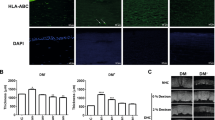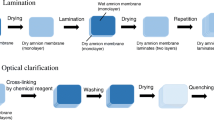Abstract
Tissue-engineered replacement of diseased or damaged tissue has become a reality for some types of tissue, such as skin and cartilage. Tissue-engineered corneal stroma represents a promising concept to overcome the limitations of cornea replacement with allograft. In this study, porcine cornea was decellularized by a series of extraction methods, and the in vivo biocompatibility of the scaffold was measured subcutaneously in rabbits (n = 8). These were not acutely rejected and no abscesses were observed by hematoxylin and eosin staining at the 8th week, indicating that the scaffolds had good biocompatibility. To investigate the potential value of clinical applications, rabbit stromal keratocytes were implanted onto decellularized scaffolds to fabricate tissue-engineered corneal stroma. Allograft, tissue-engineered corneal stroma, or scaffolds were implanted into a model of corneal ulcer. The survival and reconstruction of corneal transplantation were morphologically evaluated by light and electron microscopy until the 32nd week after implantation. Experiments involving transplantation indicated that the epithelial and stromal defect healed quickly, with improvement in corneal clarity. The integration of the graft was accompanied by neurite ingrowth from the host tissue. By 16 weeks after transplantation, the cornea had gradually regained an intact state similar to that of normal cornea. Our results demonstrate that the tissue-engineered corneal stroma with allogenetic cells is a promising therapeutic method for corneal injury.






Similar content being viewed by others
References
ARVO (1997) ARVO statement for the use of animals in ophthalmic and vision research. Invest Ophthalmol Vis Sci 38:v–vii
Bell E, Ehrlich HP, Buttle DJ, Nakatsuji T (1981) Living tissue formed in vitro and accepted as skin-equivalent tissue of full thickness. Science 211:1052–1054
Champliud MF, Lunstrum GP, Rousselle P, Nishiyama T, Keene DR, Burgeson RE (1996) Human amnion contains a novel laminin variant, laminin 7, which like laminin 6, covalently associates with laminin 5 to promote stable epithelial-stromal attachment. J Cell Biol 132:1189–1198
Chen J, Wang C, Lu S, Wu J, Guo X, Duan C, Dong L, Song Y, Zhang J, Jing D, Wu L, Ding J, Li D (2005) In vivo chondrogenesis of adult bone-marrow-derived autologous mesenchymal stem cells. Cell Tissue Res 319:429–438
Ferber D (1999) Tissue engineering. Growing human cornea in the lab. Science 286:2051–2053
George AJ, Larkin DF (2004) Corneal transplantation: the forgotten graft. Am J Transplant 4:678–685
Griffith LG, Naughton G (2002) Tissue engineering: current challenges and expanding opportunities. Science 295: 1009–1014
Griffith M, Osborne R, Manger R, Xiong X, Doillon CJ, Laycock NL, Hakim M, Song Y, Watsky MA (1999) Functional human corneal equivalents constructed from cell lines. Science 286:2169–2172
Hargrave SL, Mayhew E, Hegde S, Niederkorn J (2003) Are corneal cells susceptible to antibody-mediated killing in corneal allograft rejection? Transpl Immunol 11:79–89
Heinz C, Eckstein A, Steuhl KP, Meller D (2004) Amniotic membrane transplantation for reconstruction of corneal ulcer in Graves ophthalmopathy. Cornea 23:524–526
Hu X, Lui W, Cui L, Wang M, Cao Y (2005) Tissue engineering of nearly transparent corneal stroma. Tissue Eng 11:1710–1717
Iwamoto T, Smelser GK (1965) Electron microscopy of the human corneal endothelium with reference to transport mechanisms. Invest Ophthalmol 72:270–284
Jager MJ, Gregerson DS, Streilein JW (1995) Regulators of immunological responses in the cornea and the anterior chamber of the eye. Eye 9:241–246
Kasimir MT, Rieder E, Seebacher G, Wolner E, Weigel G, Simon P (2005) Presence and elimination of the xenoantigen gal (alpha1, 3) gal in tissue-engineered heart valves. Tissue Eng 11:1274–1280
Katami M, Madden PW, White DJ, Watson PG, Kamada N (1989) The extent of immunological privilege of orthotopic corneal grafts in the inbred rat. Transplantation 48:371–376
Kenyon KR, Tseng SCG (1989) Limbal autograft transplantation for ocular surface disorders. Ophthalmology 96:709–722
Kim JS, Kim JC, Na BK, Jeong JM, Song CY (2000) Amniotic membrane patching promotes healing and inhibits proteinase activity on wound healing following acute corneal alkali burn. Exp Eye Res 70:329–337
Larkin DF, Calder VL, Lightman SL (1997) Identification and characterization of cells infiltrating the graft and aqueous humour in rat corneal allograft rejection. Clin Exp Immunol 107:381–391
Minami Y, Sugihara H, Oono S (1993) Reconstruction of cornea in three-dimensional collagen gel matrix culture. Invest Ophthalmol Vis Sci 34:2316–2324
Mohan RR, Hutcheon AE, Choi R, Hong J, Lee J, Mohan RR, Ambrosio R Jr, Zieske JD, Wilson SE (2003) Apoptosis, necrosis, proliferation, and myofibroblast generation in the stroma following LASIK and PRK. Exp Eye Res 76:71–87
Nakazawa K, Takahashi I, Ohno Y, Sato M (1997) Modification of proteoglycan synthesis by corneal stromal cells on co-culture with either epithelial or endothelial cells. J Biochem 122:851–858
Ohno K, Nelson LR, Mitooka K, Bourne WM (2002) Transplantation of cryopreserved human corneas in a xenograft model. Cryobiology 44:142–149
Oksuz H, Duran N, Tamer C, Cetin M, Silici S (2005) Effect of propolis in the treatment of experimental Staphylococcus aureus keratitis in rabbits. Ophthalmic Res 37:328–334
Orwin EJ, Hubel A (2000) In vitro culture characteristics of corneal epithelial, endothelial and keratocyte cells in a native collagen matrix. Tissue Eng 6:307–319
Pellegrini G, Traverso CE, Franzi AT, Zingirian M, Cancedda R, De Luca M (1997) Long-term restoration of damaged corneal surfaces with autologous cultivated corneal epithelium. Lancet 349:990–993
Quantock AJ, Sano Y, Young RD, Kinoshita S (2005) Stromal architecture and immune tolerance in additive corneal xenografts in rodents. Acta Ophthalmol Scand 83:462–466
Trinkaus RV, Leibowitz HM, Ryan WJ, Kupferman A (1991) Quantification of stromal destruction in the inflamed cornea. Invest Ophthalmol Vis Sci 32:603–609
Wang LC, Chen JW, Liu HL, Chen ZQ, Zhang Y, Wang CY, Feng ZG (2004) Synthesis and evaluation of biodegradable segmented multiblock poly(ether ester) copolymers for biomaterial applications. Polym Int 53:2145–2154
Wilson SE, Liu JJ, Mohan RR (1999) Stromal-epithelial interactions in the cornea. Prog Retin Eye Res 18:293–309
Wilson SE, Netto M, Ambrosio R Jr (2003) Corneal cells: chatty in development, homeostasis, wound healing, and disease. Am J Ophthalmol 136:530–536
Author information
Authors and Affiliations
Corresponding author
Additional information
This study was supported by the Nature Science Foundation of China (project no. 30572046) and the Development of High and New Science and Technology (863 Project) of China (2002AA205041, 2005AA205241).
Rights and permissions
About this article
Cite this article
Zhang, C., Nie, X., Hu, D. et al. Survival and integration of tissue-engineered corneal stroma in a model of corneal ulcer. Cell Tissue Res 329, 249–257 (2007). https://doi.org/10.1007/s00441-007-0419-1
Received:
Accepted:
Published:
Issue Date:
DOI: https://doi.org/10.1007/s00441-007-0419-1




